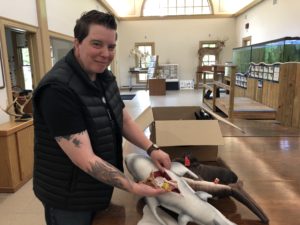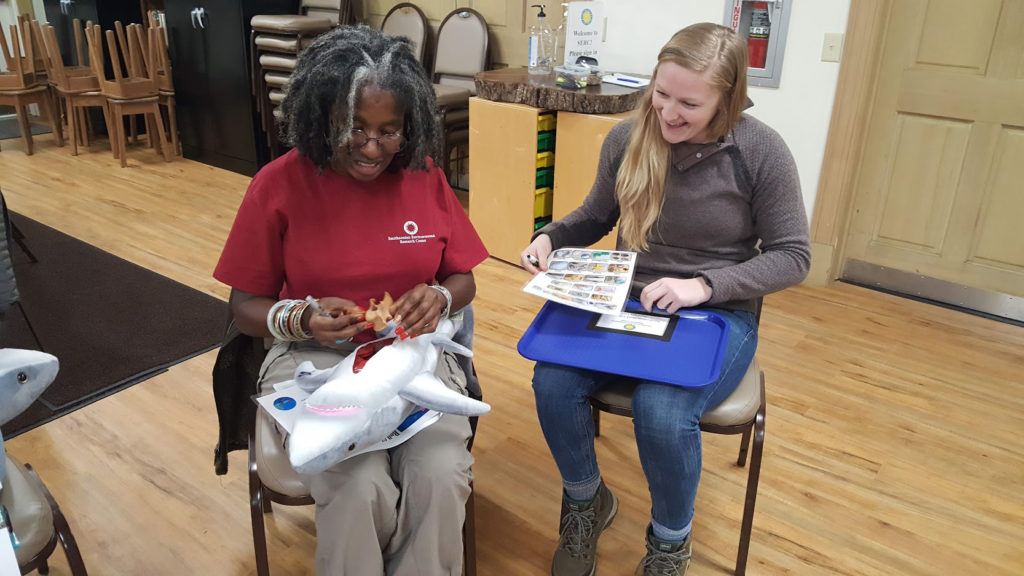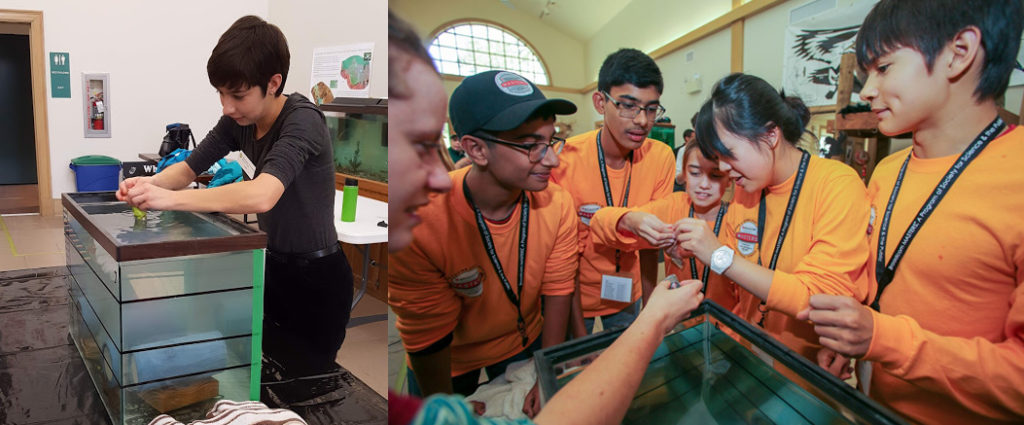by Kristen Minogue

SERC education coordinator Karen McDonald shows the contents in a stuffed shark stomach: bits of bone, a toy turtle and plastic. (Credit: Kristen Minogue/SERC)
Move over, blue crabs. There’s a new predator in the education department. Sharks are making waves as the latest addition to field trips and engineering programs at the Smithsonian Environmental Research Center (SERC).
This spring, SERC added sharks as another station in its “Shoreline Connections” and “Exploring Nature” field trips. The education staff also created a day-long program that lets students think like scientists by planning a shark tagging expedition and designing their own shark tags.
“Most of the students and teachers and even parents don’t realize that there are sharks and rays in the Chesapeake Bay,” said Karen McDonald, director of SERC’s education center. “So this is new to them. And typically the organisms are vilified. So this is a chance for us to show their importance in the ecosystem.”
The Short Swim
Shoreline Connections is SERC’s most popular field trip, geared for grades three through eight. As the name implies, it highlights the connections between people, animals and the overall Bay ecosystem through hands-on activities at different stations, all designed to fit the Next Generation Science Standards.
The theme for the 45-minute shark station is balance. As top-level predators, sharks are key to maintaining balance in the food web. Students learn what sharks eat by dissecting a stuffed (not real) shark and examining what’s in its “stomach.” But they find more than fish and shrimp inside. Plastic pollution is contaminating sharks’ diets, so educators have also stuffed the sharks with candy wrappers and other bits of plastic.
“A larger shark, like a bull shark, might accidentally swallow a bottle thinking it’s a fish,” McDonald said.
Sharks don’t even need to swallow plastic directly for it to get into their systems. Smaller creatures like shrimp can ingest tiny microplastics in the ocean. As sharks eat more plastic-infested prey, the plastic builds up in their bodies too. That’s a concept kids can grasp almost innately, according to McDonald—even if at first they’re surprised to discover there’s trash in sharks.

Volunteer Rhonda Dyson (left) and SERC public engagement specialist Cosette Larash examine the contents of a stuffed shark. (Credit: SERC)
The Deep Dive
But some schools are looking to go deeper than a 45-minute overview. For them, SERC offers a day-long STEM program called “Movement of Life: Shark and Shark Migration.”
The shark migration program is one of three full-day engineering and design programs at SERC. It challenges students to take on the role of scientists: Examine real shark migration data, plan a shark tagging expedition and design a functional shark tag.
Of course, any professional experiment has to include a budget.
“We felt like that was a more realistic lab setting, to have a budget that students would really have to think about,” said Katherine Harris, a SERC education intern who helped design the program last fall. “We can’t just go out whenever we want to and just hope to find a shark off the coast and just magically have tags.”
The students have $15,000 to work with. It doesn’t take long to discover a research trip eats money about as fast as a shark eats…well, almost anything.
“The kids all complained because insurance was so expensive,” McDonald said. “They didn’t know that insurance was so expensive. And of course, we were all laughing and telling them, yeah, that’s part of being a scientist.”
Engineering the Future
By far the biggest test is designing a special “pop-off” shark tag. To work, the tag has to stay in the center of the water when attached to the shark, so it won’t pull the shark up or drag it down. But once it pops off (usually via natural decay), it needs to float to the surface. There, it can send its data via signal to the nearest satellite.
Pop-off tags are still a work in progress in the real world, with scientists honing and testing them. For now, most biologists track sharks with internal tags that emit signals from inside the shark’s bodies. If scientists can crack the code on external pop-off tags, it could make following shark migrations far simpler and cheaper.
“We’re giving students a real-life problem that hasn’t been solved yet,” McDonald said. “It gives them that look into, hey, this is something scientists and engineers haven’t figured out. Can you figure it out?”

Left: SERC education intern Katherine Harris tests a shark tag over a tank. (Credit: SERC) Right: A team of Broadcom Master’s students test out their own shark tag. (Credit: SSP/Linda Doane)
The first students to test the full program were the Broadcom MASTERS, a collection of some of the smartest middle-school science students in the U.S. They successfully created pop-off tags that floated to the surface when required, though (unlike in a true scientific study) the tags weren’t expected to collect any data. Later classes have also solved the puzzle, sometimes with a bit of trial and error.
The simplest designs often work best. For McDonald, that’s a good thing. “That actually shows students that you don’t have to always be the biggest, loudest, largest,” she said.
The tag challenge also helps dispel another misconception—not about sharks, but about science. Engineering, at its heart, takes a lot of imagination.
“There’s also a creative component to all of these processes and designing new technologies,” Harris said. “There’s a lot of creativity that has to go into it.”
If the students can see themselves as scientists, even just for one day, the program will be a success. Like most who work in science, McDonald and Harris know that science isn’t so much about having the answers, but about finding the answers with critical thinking. And if sharks can be the messengers, well, that’s one more way the ocean’s most vilified predators can reclaim their image.
Educators: To sign up for one of our field trips or Engineering & Design STEM programs, visit our School Programs page and fill out our Field Trip Request Form. Contact Karen McDonald (mcdonaldk@si.edu) for more information.
Further Reading:
Jawshank Redemption: Understanding Shark Behavior Through Science
Following the Movement of Life: Tagging Sharks and Rays
Understanding Sharks One Tag at a Time
Intern Logs: Tagging Sharks in the Sunshine State

